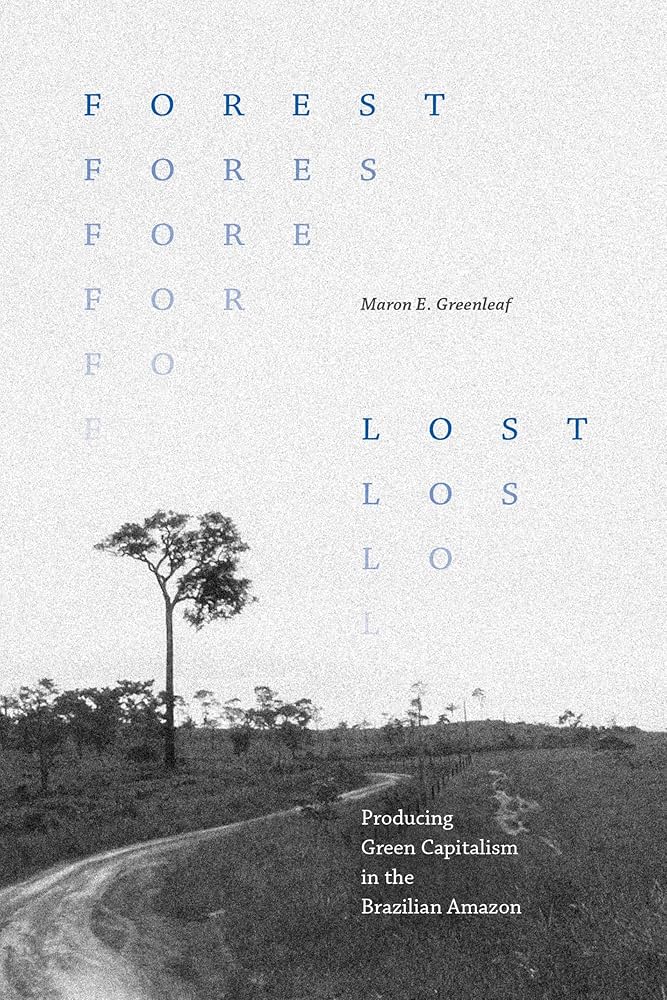Documenting a Carbon Bust
Review of
Forest Lost: Producing Green Capitalism in the Brazilian Amazon
Durham, NC: Duke University Press, 2024, 304 pp

Maron E. Greenleaf’s Forest Lost: Producing Green Capitalism in the Brazilian Amazon is a timely and critical examination of how market mechanisms—specifically, carbon markets and environmental services—have been applied to conservation policies in the Brazilian Amazon. Greenleaf conducted extensive ethnographic research in Acre, a Brazilian state that has pioneered many market-based environmental policies. The focus of Greenleaf’s study is the System of Incentives for Environmental Services (SISA), a state program intended to “protect the living forest by making it into a source of economic value, and, in this sense, to make capitalism green,” according to Greenleaf.
The central purpose of SISA, writes Greenleaf, was to “sell forest carbon credits (representing reductions or removals in [greenhouse gas] emissions), receive payments for emissions reductions, and otherwise pursue monetary compensation for protecting the rainforest.” Proponents of carbon markets like this one often emphasize the economic benefits of forest conservation. But Greenleaf found that they were a poor fit for people in rural Acre, who survive by rubber tapping, Brazil nut harvesting, logging, or scraping a meager living from small farms and ranches. Greenleaf’s research demonstrates how the rhetoric of sustainability, efficiency, and market-driven conservation often obscures the material consequences and lived experience of these policies.
What was framed as a “win-win-win” solution “in which profit, smallholder benefits, and environmental sustainability reinforce each other” ultimately became an exercise in shifting responsibility.
One smallholder in Acre, for example, applied for SISA benefits but struggled with the bureaucratic requirements needed to qualify for compensation: “Angelo estimated that he had visited Acre’s land agency, Iteracre, some forty times in all to get title. Yet even with access to free legal counsel and the legal merit of their claim, he and [his wife] Lucia had failed to get it.” What was framed as a “win-win-win” solution “in which profit, smallholder benefits, and environmental sustainability reinforce each other,” Greenleaf writes, ultimately became an exercise in shifting responsibility—one where Acre’s rural poor were expected to bear the costs of global environmental governance.
A key contribution of Forest Lost is its examination of the “carbon boom” and subsequent “carbon bust”—the gap between the expectation that carbon markets would generate substantial revenue for rainforest conservation and the reality that such funding never fully materialized. Bureaucratic inefficiencies with high administrative costs limited market accessibility on the part of Brazilians, while market fluctuations, combined with fears of corporate greenwashing, discouraged international investors.
Greenleaf’s analysis shows how conservation efforts can exacerbate both current and historical processes of marginalization. She argues that the programs aimed at empowering local communities in fact deprive the Indigenous and smallholder residents of their autonomy because core policy decisions are made by government officials, nongovernmental organizations, and international funding bodies. In addition, the benefits of these policies were skewed in favor of large landowners—whose property, Greenleaf notes, was often acquired through the expulsion of Indigenous people and posseiros, or rubber tappers who lacked formal land rights—causing further structural inequities while bringing in little engagement from smallholders and Indigenous communities.
Programs aimed at empowering local communities in fact deprive the Indigenous and smallholder residents of their autonomy.
While Greenleaf critiques green capitalism effectively, a fuller discussion of grassroots-led conservation efforts and state-led regulatory alternatives would have strengthened her argument. There are participatory conservation models in Ecuador and Bolivia that suggest how conservation can be supported via local management and sustainable use of resources without resorting to financial instruments such as carbon credits. Likewise, the Bolivian Indigenous-led conservation initiatives and rights-based approaches, such as the Accelerating Inclusive Conservation in the Tropical Andes project, concentrate on strengthening traditional management of lands. A comparative analysis would have given a much better understanding of the successes and failures of Acre’s approach.
Coming from a background in science and technology studies, I found Greenleaf’s challenge to broadly accepted policy narratives extremely stimulating. It made me question the assumptions on which much modern conservation discourse rests—such as the belief that financial incentives naturally lead to conservation success or that carbon offsetting provides an equitable solution to emissions reduction.
Greenleaf’s work pushes for a deeper integration of equity considerations into environmental governance frameworks, while demonstrating how green capitalism has reinforced global inequalities by allowing polluting industries in the Global North to offset emissions while placing the burden of conservation on communities in the Global South.
